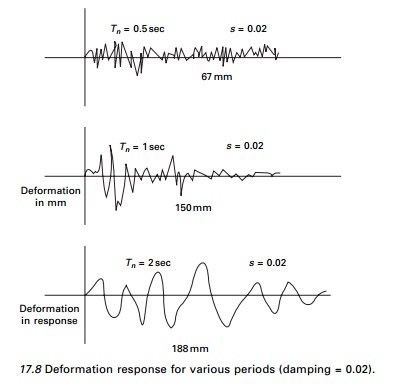Chapter: Civil : Structural dynamics of earthquake engineering
Importance of response quantities
Importance of response
quantities
For structural engineers, the
deformation of the system or relative displacement with respect to the ground
is of great interest. Internal forces, base shear and moments are usually
related to displacement. Knowing the total displacement of the mass ut(t)
would be useful in providing a separation between adjacent buildings to prevent
their pounding against each other during an earthquake. Pounding is the
main cause of damage to several buildings during almost every earthquake.
Similarly, the total acceleration is obtained by supporting sensitive equipment
and the motion imparted to the equipment can be determined.
1 Response history
For a given earthquake ground motion u˙˙g
( t ) , the deformation depends on natural period of vibration and
damping ratio. Figure 17.8 shows the deformation response of three different
systems due to electro ground motion.

The damping factor is 2%. The
only difference among the three systems is the natural periods. It is also seen
that the time required for a SDOF systems to complete a cycle of vibration when
subjected to earthquake ground motion is also equal to the natural period of
displacement. Peak displacement is shown in each case
The longer the natural period, the greater the peak
deformation. Figure 17.9 shows the deformation response of three systems to the
same ground motion. Vibration period Tn is the same for all
but damping is different. From Fig. 17.9 we can observe that systems with more
damping respond less than lightly damped systems because the natural periods of
three systems are same. Once U(t) is known the base shear V
may be calculated (see Fig. 17.10).
Fs(t) = Vb(t)
= K U(t)
--- --- 17.12
Equivalent static force is introduced which is a
central concept in earthquake response of the structure. At any instant of time
t, the force Fs is the static (slowly) applied force that will
produce deformation U(t)

Observe that the equivalent
static force is m times A(t), the pseudo-acceleration, not
m times total acceleration.
The pseudo-acceleration response can be calculated from the
deformation response for the three systems Tn = 0.5: wn
= 12.56: A for (Tn = 0.5) is calculated as (see Fig. 17.8)

For Tn = 1 s A
= 0.603g; for Tn = 2 s, A = 0.188g. The
pseudo-acceleration graphs are presented in Fig. 17.11.
Thus a static analysis of structure would be required at each
time when the response is desired. The base shear and base moment are
calculated as
Vb(t) = fs(t);
Mb(t) = hfs(t)
Vb(t) = mA(t);
Mb(t) = Vb(t)h 17.14
Related Topics